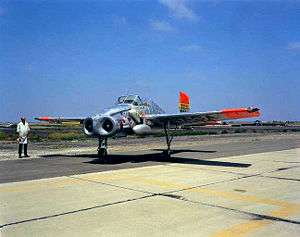Bell X-14
| X-14 | |
|---|---|
 | |
| Bell Type 68 VTOL | |
| Role | Experimental VTOL |
| Manufacturer | Bell Aircraft |
| First flight | 19 February 1957 |
| Retired | 29 May 1981 |
| Status | Museum Display |
| Primary users | NASA United States Air Force |
| Number built | 1 |
|
| |
The Bell X-14 (Bell Type 68) was an experimental VTOL aircraft flown in the United States in the 1950s. The main objective of the project was to demonstrate vectored thrust horizontal and vertical takeoff, hover, transition to forward flight, and vertical landing.
Design and development
| Bell X-14 thrust vectoring vanes | |
|
|
Bell constructed the X-14 as an open-cockpit, all-metal (duralumin) monoplane for the USAF. It was powered by two Armstrong Siddeley Viper turbojet engines equipped with thrust deflectors sited at the aircraft's centre of gravity. The engines are fixed in position; transition from vertical to horizontal flight is achieved with a system of movable vanes that control the direction of engine thrust.[1][2] Top speed was 180 miles per hour with a service ceiling of 20,000 feet. The X-14 was designed using existing parts from two Beechcraft aircraft: wings, ailerons, and landing gear of a Beech Bonanza and the tailcone and empennage of a Beech T-34 Mentor.[3]
Operational history
The X-14 first flew on 19 February 1957 as a vertical takeoff, hover, then vertical landing. The first transition from hover to horizontal flight occurred on 24 May 1958. In 1959, its Viper engines were replaced with General Electric J85 engines. That year the aircraft was also delivered to the NASA Ames Research Center as the X-14A. During the development of the P.1127, Hawker test pilots Bill Bedford and Hugh Merewether visited NASA Ames to fly the X-14 and acquaint themselves with jet V/STOL aircraft handling prior to the first flights of the prototype P.1127.[3] It served as a test aircraft with NASA until 1981.
The X-14 project provided a great deal of data on VTOL (Vertical TakeOff and Landing) type aircraft and flight control systems. The X-14A also was used by NASA for research on lunar landing maneuvers. The X-14A aircraft flight control system was similar to the one proposed for the Lunar Module. Neil Armstrong, the first man to walk on the Moon, once flew it as a lunar-landing trainer.
In 1971, the X-14A was fitted with new engines (General Electric J85-GE-19) and redesignated the X-14B. An onboard computer and digital fly-by-wire control system were also installed to enable emulation of landing characteristics of other VTOL aircraft.
The X-14B was used in this test role until it was damaged beyond repair in a landing accident on 29 May 1981. At the time, there were plans to develop an X-14C with an enclosed cockpit. There were also plans for an X-14T trainer. None of these further versions got beyond the planning stage.
During all of its years of service, the X-14 was flown by over 25 pilots with no serious incidents or injuries.
Aircraft serial numbers
Although there was only one airframe, it changed serial numbers with every major upgrade.
- X-14 - USAF 56-4022
- X-14A - NASA 234 (N234NA).
- X-14B - NASA 704 (N704NA).
Survivor
The X-14 was rescued from the scrap yard in 1999 and is currently undergoing renovation as part of a private collection in western Indiana. The collection is displayed at the Ropkey Armor Museum.[4][5]
Specifications (X-14A)
Data from
General characteristics
- Crew: 1
- Length: 25 ft 0 in (7.62 m)
- Wingspan: 34 ft 10 in (10.36 m)
- Height: 8 ft 0 in (2.40 m)
- Loaded weight: 3,100 lb (1,406 kg)
- Max. takeoff weight: 4,269 lb (1,936 kg)
- Powerplant: 2 × Armstrong Siddeley Viper 8 Turbojet, 1,750 lbf (7.8 kN) each
Performance
- Maximum speed: 172 mph (277 km/h)
- Range: 300 miles (482 km)
- Service ceiling: 20,000 ft (6,096 m)
- Thrust/weight: 1:0.9
See also
- Aircraft of comparable role, configuration and era
- Related lists
References
| Wikimedia Commons has media related to Bell X-14. |
- Notes
- ↑ US patent 2879014, Smith, Stanley W.; Sperazz, Charles M. (Sr.), "Jet Propelled Airplane With Jet Diverter", issued 1959-03-24
- ↑ "Picture of Bell X-14 moveable vanes for thrust vectoring". web site, ropkeyarmormuseum.com. Ropkey Armor Museum. Retrieved February 12, 2013.
- 1 2 Borchers, Paul F.; Franklin, James A.; Fletcher, Jay W. (1998). "Chapter 8, Boundary Layer Control, STOL, V/STOL Aircraft Research". (SP-3300) Flight Research at Ames, 1940-1997, Fifty-Seven Years of Development and Validation of Aeronautical Technology. NASA. pp. 55–59. Retrieved February 12, 2013.
- ↑ Lowther, Scott. "Bell X-14." up-ship.com. Retrieved: 3 May 2012.
- ↑ "Bell X-14B." Ropkey Armor Museum, 2012. Retrieved: 3 May 2012.
- Bibliography
- Markman, Steve and William G. Holder. Straight Up: A History of Vertical Flight. Atglen, Pennsylvania: Schiffer Publications, 2000. ISBN 0-7643-1204-9.